One of the main benefits of a multi-effects pedal for beginners is the cost savings it can provide. Beginners can get all the effects they need in one device instead of buying several individual pedals.
This can be especially useful for beginners who aren’t sure what pedal they want or need, as it allows them to experiment with a variety of effects without a huge financial investment.
Are multi-effects pedals good for beginners?
While some simple multi-effects units can provide a convenient setup for beginners, most multi-effects units are aimed at advanced guitarists.
These pedals require knowledge of traditional FX pedals, sound shaping, and EQ, and can be difficult for beginners to understand. A better option for beginners is a combo amp with built-in multi-FX.
Best Guitar Multi Effects Pedals for Beginners
1. FLAMMA FX200 Multi-Effects Guitar Pedal
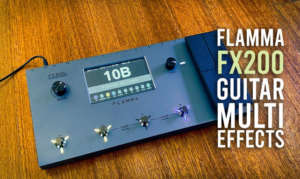
The FX200 multi-effects pedal from Flamma features a 5-inch touchscreen, easy-to-use software editing, adjustable effects chains, 30 cabinet simulations, 4 footswitches, programmable MIDI ports, and expanded I/O for all your musical needs.
Plug and play with presets or customize your sound with auxiliary inputs, expression pedals, stereo FX loops, and more.
The FLAMMA FX200 is a multi-effects guitar pedal that offers guitarists a wide range of customizable sound options.
With a 5-inch LCD touchscreen, this pedal allows users to easily navigate through the various settings and adjust their sound to their pereference.
With 10 effects modules and 160 different types of effects, the FX200 offers users a wide range of options to explore.
One of the standout features of this guitar pedal is its editable effects chain, allowing musicians to change the order of the modules to create their ideal sound.
This pedal also boasts an extensive input/output (I/O) system, making it versatile for studio, live performance, or practice settings.
The FX200 comes with 58 built-in preamp models and 30 high-quality cabinet simulations, allowing users to recreate the feel of a true tube amplifier.
Additional features include 80 drum machine variations, 10 metronome styles, and a 52-second looper, giving guitarists a comprehensive toolset to enhance their playing experience.
2. Boss ME-90 Guitar Multi Effects Unit
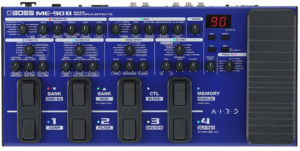
The BOSS ME-90 guitar multi-effects unit is a versatile and powerful addition to the BOSS ME series, offering exceptional audio quality, flagship-grade AIRD amp models, IR loading, and more.
This all-in-one processor is designed for convenience and delivers premium BOSS tones with ease.
The ME-90’s knob-based interface makes creating sounds as simple as manipulating a stompbox pedalboard.
It offers a wide range of effects, including overdrive, distortion, pitch/mod effects, delay, reverb, and more, with a total of 60 effects types.
Build your own custom setups easily with 36 preset patches and 36 user patches.
Eight footswitches and a redesigned expression pedal give you easy real-time control, giving you access to patches, effects, and more.
The ME-90 also boasts high-quality amp models powered by AIRD technology, delivering a wide range of authentic tube tones.
With support from BOSS Tone Studio, you can further customize your sounds, edit patches, and expand your creative possibilities.
The ME-90 is lightweight, durable, and battery-powered for on-the-go use, making it a great choice for performance guitarists looking to shape their tone with precision and flexibility.
3. Boss GT-1 Multi-FX Pedal
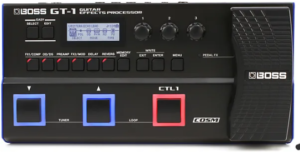
Boss is one of the kings of multi-effects pedals, and their products have a reputation for being solid, durable, well-specced, and producing great tones.
The GT-1 is aimed at beginners and those with little pedal experience, but it doesn’t disappoint.
The GT-1 includes 108 different effect types, 99 presets, 99 user patches, and a 32-second looper, making this multi-effects unit a versatile and useful learning tool.
The looper is ideal for those looking to practice their timing and the internal metronome is ideal, especially for beginners.
Powered by four AA batteries, it can be powered for up to seven hours, or you can use a 9V DC power supply to ensure your tone never runs out.
The built-in USB port is great for downloading more sounds, using an online editor, or using it as an audio interface when recording.
It’s a little more basic than you might expect, but for the price, there’s nothing to complain about.
4. Mooer GE200 Multi-Effects Pedal
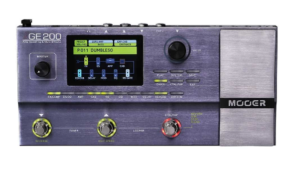
Chinese brand Mooer has slowly but surely built a reputation for striking a good balance between price and performance.
Starting out as a brand that offers low-cost versions of popular pedals, it’s now considered a real contender in the mid-to low-end market.
The Mooer GE200 is a great example, offering a wide range of effects, models and tools, and looking (or sounding) like it belongs on devices much higher up the effects chain.
All 70 included effects sound great, and I particularly like the ability to load your own impulse response to fine-tune the speaker output. Very capable, and definitely worth a look.
5. Zoom G1Xon
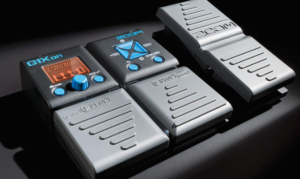
As someone who has been playing guitar since 1990 and keeps up to date with gear, I am blown away by the value that the Zoom G1Xon offers.
I think it’s fair to say that this pedal does it all, and it’s amazing that it does it all for less than the standard pedals from big brands like BOSS or TC Electronic.
The G1Xon (what a catchy name!) comes with 75 effects and 14 simulated amp sounds (which also change the sound), as well as other nice features like a looper, tuner, drum beats, and a wah pedal.
This device comes with 75 effects, which is a very wide selection. Basically, the sounds you get from this multi-pedal are clones of popular guitar effects pedals.
Most of them are eerily similar to the real thing, and it’s very hard to tell the difference.
The effects range from standard distortion/fuzz effects to a very wide range of time-based effects (reverb, delay, echo, etc.), and there are also some unexpected niche or weird sounds.
I own a Zoom G1Xon and honestly can’t think of a single guitar effect that doesn’t have a version here.
But that’s not all there is to this device. The G1Xon also includes a number of amp simulations, allowing you to sound like you’re using all sorts of expensive amps, from vintage blues classics to modern metal machines.
There’s also an expression pedal built-in. This pedal can be used to control volume, but most people will want to use it as a wah pedal.
I’ve tried this, and the wah sounds are amazing and crazy fun (as are all wah pedals, in my opinion).
That’s all? Absolutely not! The pedal also has a guitar tuner built in, which you can activate at any time by pressing both pedals at the same time.
This is incredibly useful for anyone, regardless of experience level or musical style.
6. Line 6 Helix Floor Amp and Multi-Effects Guitar Pedal
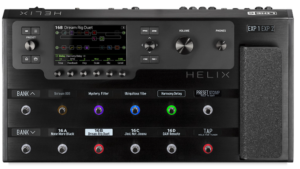
The Line 6 Helix Floor Amp and Multi-Effects Guitar Pedal is widely regarded as one of the leading multi-effects and modelers on the market.
It’s a true digital heavyweight. Line 6’s flagship product, the Floor, boasts the widest range of sounds, features, and settings available to sound professionals.
Featuring dual SHARC processing, it delivers digital horsepower to create the highest quality analog sounds.
In contrast, the exceptional HX modeling process delivers complete tonal authenticity with its amps, effects, and cabinets.
Despite its feature-packed nature, the Helix Floor is certainly not compact.
Sure, it’s much more compact than a full-size pedalboard, but if you’re looking for a backpack-sized model that you can easily lug around to your local gig or rehearsal room, this isn’t it.
But if size isn’t a concern, the Helix Floor is a worthy option for both stage and studio use.
Thanks to its larger size, it boasts additional footswitches, expanded signal processing range, and an overall increase in functionality over smaller multi-effects, delivering the best possible performance.
Featuring balanced XLR outputs, dual effects loops, and MIDI control, it’s a musician’s dream for complex setups and professional-level recording.
7. Line 6 HX Stomp
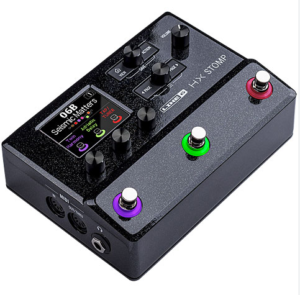
The HX Stomp includes over 190 effects, including Helix, M Series, and legacy Line 6 patches, as well as a full-fat Helix amp, cabinet, and mic option.
It also supports impulse response loading, so if you’ve modeled your amps or purchased commercial IRs from elsewhere, you can load them into the pedal.
It’s certainly impressive and no small feat to pack the sound of these devices, as well as a full-color display, into a device the size of the HX Stomp.
With MIDI in and out, it’s certainly a consideration for those looking to integrate the HX Stomp into a pedal-switcher-controlled rig. In that context, it’s easy to see the appeal.
The HX Stomp is limited in terms of controls on the front, but it’s highly customizable and offers a wide range of professional-level effects to explore.
For guitarists who want a cabinet simulation for a specific modulation, delay or tap ‘just in case’, the HX Stomp is a smart, compact solution, and the capacitive footswitches make assigning and editing a relatively error-free process.
8. Eventide H90 Harmonizer
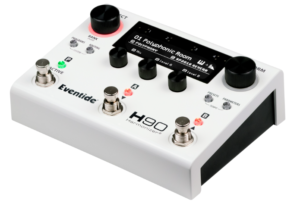
The Eventide H90 Harmonizer is the successor to the cult classic Eventide H9, which can be found on many pro guitarists’ pedalboards.
Many guitarists have taken full advantage of the board’s incredible algorithms by adding two H9s to their boards, so it made sense for Eventide to essentially merge the two H9s into one device for the next version.
The H90 does a fantastic job of combining more conventional delays and reverbs with some weird pitch-shifting effects to create something perfect for sonic explorers.
If you’ve tried all the effects and feel like nothing is quite right for you, this powerful kit could be the perfect fit.
The routing options for integrating them into your rig are incredibly versatile, and you can choose to run the effects before or after your amp for added flexibility.
Not only is this a very powerful tool for guitarists, but it’s also great for studio use thanks to its excellent editing app.
FAQs
What is a multi-effects pedal?
A multi-effects pedal is often referred to as a pedalboard replacement, while a full rig replacement is often referred to as a floor modeler.
Confusingly, these two terms are often used interchangeably, so it’s definitely wise to investigate the feature sets of these multi-effects pedals to see if they meet your needs.
Some of the devices here are designed to replace existing pedalboards, featuring a variety of effects pedals such as overdrive, distortion, delay, modulation, and reverb.
This makes for a quick and easy setup for practice or on stage, while also reducing the chance of one of the patch cables or power supplies failing mid-set.
What to Look for in a Multi-Effects Pedal?
For the novice guitarist, having one of these types of multi-effects pedals is a great way to get into the world of effects. This allows you to pick up most of the sounds and experiment with them to find the ones you like.
Every great guitarist has a ‘personal sound’ and having a multi-effects pedal can help you get one step closer to discovering your own sound.
For the advanced player, a multi-effects pedal can be a way to fill a busy pedalboard with more effects and mix it with a regular stomp box to create a hybrid pedalboard.
As technology advances, multi-effects pedals can emulate not only pedalboards but also amps and cabinets.
Some of the simulations available are downright amazing and give you the option to reduce your entire rig to just your guitar and a backpack.
For the travel-weary guitarist who has been lugging around tube amps for decades, this is a welcome development. While a full-fledged floor modeler may seem like a given, there are a few things to watch out for.
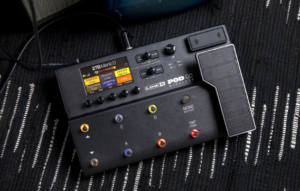
Should I Buy a Floor Modeler?
With the latest floor modelers, you have a lot of choices. For those who aren’t sure what they want out of their sound, this can be a real positive.
For others, the sheer amount of choice means they spend too much time tweaking and not enough time actually playing.
If you have a wealth of knowledge about effects and guitar amps, it’s much easier to get lost in a complex floor modeler.
However, I wouldn’t recommend it for beginner guitar players.
With a floor modeler, you need a way to monitor your sound, whether at home, in the practice room, or on stage.
Even with big tube amps on stage, it can be difficult to cut through a muddy monitor mix, and playing without being able to hear yourself is a guitarist’s worst nightmare.
Luckily, there are some great full-range, flat-response monitors (called FRFRs) that are specifically made for this kind of thing.
The best FRFR speakers will give you a completely neutral monitor mix, so you can always hear your carefully crafted guitar tone, whether on stage or in rehearsal.
Are multi-effects pedals worth it?
It is widely agreed that multi-effects pedals are worth it for guitarists of all levels.
The variety of textures, sonic shaping, amp models, and cabinet impulse responses (IRs) allows for a huge amount of creative freedom without being tied down to expensive gear.
What connectivity do I need for my multi-effects pedal?
Finally, you’ll want to look at connectivity. Many multi-effects pedals have a variety of connection options, but it’s always wise to make sure you have the connections you need to integrate them into your existing rig.
If you use your home recorder regularly, USB output or direct output is a must. If you practice at home, make sure it has a headphone output.
If you have a complex stereo amp setup or want to utilize an FX loop, look for pictures on the back of your device or in the manual to make sure you can get the most out of your multi-effects pedal
Conclusion
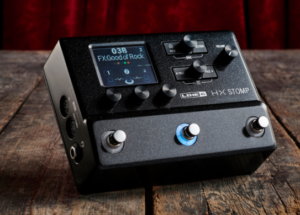
Multi-effects pedals are a great option for beginning guitarists, offering a variety of effects in one device, saving money and time in the setup process.
These pedals also often have the ability to create and save custom effects settings, giving users more control over their sound.
However, multi-effects pedals may not offer the same level of sound quality as individual pedals, and they can be more difficult to use and repair.
Despite their shortcomings, multi-effects pedals are an ideal starting point for guitarists looking to explore the world of effects and enrich their playing experience.
With such a versatile device, trial and error can help you choose a more robust multi-effects pedal or more carefully evaluate upgrades when embarking on a classic stompbox journey.
Also read: 10 Best PA Systems for Large Venues in 2024
